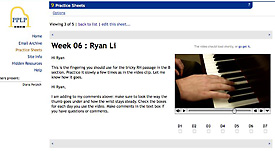As director of the Piano Pedagogy Laboratory Program (PPLP), John Ellis oversees the training of graduate students who instruct youngsters from Ann Arbor in piano during the week at the School of Music, Theatre & Dance both through private lessons and group classes.
Ellis, associate professor of music and chair of the Department of Piano, had been trying to think of way to integrate the venerable European system of multiple private lessons during the week with the American one-lesson-per-week standard. Then he started seeing those little digital video cameras that were just coming on the market. This coincided with a call for proposals from the Center for Research in Learning and Teaching for its 2010 Teaching with Technology Institute.

The Online Video Pedagogy Project allows students to videotape an instructor’s demonstration for reference.
He wrote a proposal, with the help of School of Music, Theatre & Dance IT Manager Greg Laman, that sought to allow teachers to continue giving targeted instruction during the child’s practice week by placing short instructional video clips with written annotations online. It also would help parents have a clearer sense of how they can assist their children in their piano education at home. His proposal was accepted by CRLT in April.
Throughout the summer, he worked with team of technology experts assembled by CRLT from around the university. They helped Ellis and PPLP webmaster Aya Higuchi to mold the project and make the dream a reality.
Crucial to this effort was Diana Perpich, IT senior consultant at the Digital Media Commons. She spent many hours finding ways to enable the project to succeed. What has emerged, after many hours of technical work and trial and error is the Online Video Pedagogy Project.
Since young people these days are in love with videos and technology, Ellis thought, a system like this would be the best way to reach them. And he was right. Students in the program say they love it; so do the graduate student instructors. On the site, each student accesses his or her own private practice sheets, which consist of video clips and written instructions. The site also features check-boxes for each day of the week so instructors can see how much practice time students have put in and a box where the student can write questions or comments about how the video is working.
As part of the grant, Ellis was able to purchase 13 small Kodak Zi8 video cameras, which he signs out to his graduate students and staff teachers. Videos are made during lessons, either by the teacher of the student or — even more effectively — by the student videotaping his teacher demonstrating the correct technique. It turns out that the focus required by the student to make the videotape reinforces the learning process. Those videos are posted and show the parents what to look for and how to guide their children.
“It’s a very effective way to pinpoint problems,” Ellis says, “and it stimulates so much interaction.” They also videotape student recitals so the player can observe body posture and stage presence, as well as hear where passages could use improvement. “The idea behind that is positive reinforcement,” Ellis says, “rather than just correcting problems, we also can capture moments when the student is playing correctly and reinforce that.”
Ellis says this first go-round is the prototype; over the course of the semester, it is being tweaked and refined. In the future, he would like to develop a system that is even more interactive in order to, as he says, “break down the walls of the traditional piano lesson.” He also plans to use it as the basis of further research into pedagogy.
But for now, Ellis’ Online Video Pedagogy Project is up and running and he says he is enthusiastic about the help he received from CRLT.
“Erping Zhu and Charles Dershimer from CRLT believed in the idea when it was still somewhat vague,” he says. “They helped me get it organized and assigned several excellent people to brainstorm with me on it. This culminated in the work of Diana Perpich, who made it a reality. I am really grateful to her for her indefatigable efforts on the project. I look forward to expanding this in the future.”

